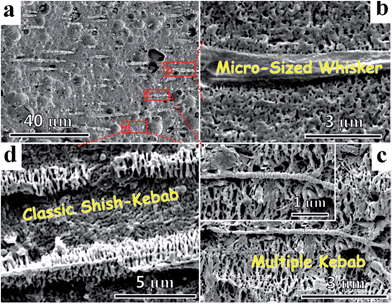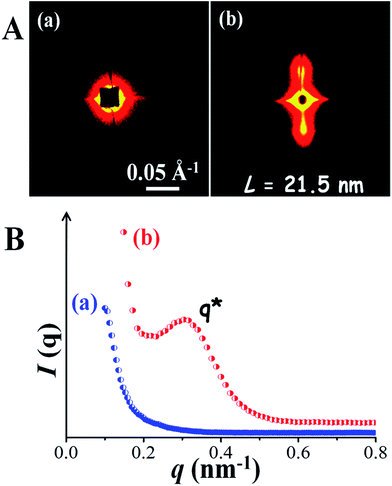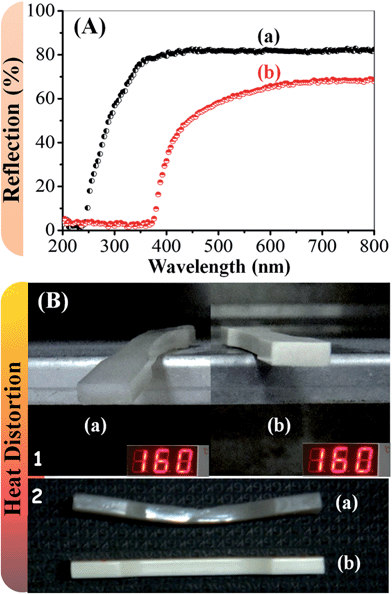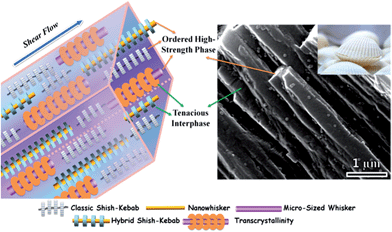Strong and tough micro/nanostructured poly(lactic acid) by mimicking the multifunctional hierarchy of shell†
Huan
Xu‡
a,
Lan
Xie‡
a,
Jing-Bin
Chen
a,
Xin
Jiang
a,
Benjamin S.
Hsiao
b,
Gan-Ji
Zhong
*a,
Qiang
Fu
a and
Zhong-Ming
Li
*a
aState Key Laboratory of Polymer Materials Engineering, College of Polymer Science and Engineering, Sichuan University, Chengdu, 610065, Sichuan, People's Republic of China. E-mail: ganji.zhong@scu.edu.cn; zmli@scu.edu.cn
bDepartment of Chemistry, Stony Brook University, Stony Brook, New York 11794-3400, USA
First published on 1st July 2014
Abstract
This effort discloses a bioinspired methodology based on widespread polymer processing techniques for the fabrication of shell-mimicking structural poly(lactic acid) (PLA), one of the most important biodegradable polymers, but suffering from limited strength, toughness and heat resistance. The ordered, micro/nanostructural assembly consisting of a high-strength phase and tenacious interfacial ligaments was established in the shell-mimicking PLA by virtue of employing customized zinc oxide (ZnO) whiskers and intensive shear flow. Demonstration of the exceptional properties for the structured PLA is presented, outperforming normal PLA with nearly double the tensile strength (119.4 MPa) and over 2.5-fold improvement in impact toughness (11.5 KJ m−2), as well as the largely enhanced resistance to heat distortion and almost perfect UV light shielding efficiency. The high strength and toughness are unprecedented for PLA, and are in great need for structural applications.
Conceptual insightsThe biomimetic design principles described herein—creation of a shell-mimicking assembly constituting a compact rigid phase and ordered tenacious filaments—are extended to make a new type of polymer composite, which is composed of well-aligned multiscale inorganic rigid fillers, highly oriented polymer crystals (i.e., the so-called classic shish–kebab and hybrid shish–kebab crystals), and polymer transcrystallites. The formation of such unique superstructures and organization of the incorporated fillers were realized by a widespread polymer processing technique, wherein a controllable, strong shear flow field was externally applied. The unprecedented reinforcing and toughening effects were achieved for nonfibrous poly(lactic acid) (PLA), one of the most important biodegradable polymers but suffering from limited strength, toughness and heat resistance. The flexibility in the choice of polymer matrices and multifunctional fillers permits broad applications in the fabrication of other specific composites toward low-cost, high-performance, large-scale commodities. |
The past decades have witnessed revolutionary developments of nanostructured materials to offer unusual properties.1–7 An important task in developing nanostructured materials is to translate competently the genuinely amazing properties of individual nanostructures (e.g., nano-sized whiskers, tubes, sheets, etc.) to larger scales.8–13 Unfortunately, the field of engineered, nanostructured materials is still in its infancy. This is primarily caused by the bottlenecks involving engineering the nanostructures with control, affording materials with an incredible range of functional properties, and developing industrial processes for forming the anticipated structures.14 As a relatively new but rapidly rising approach, bionics signifies a promising strategy to build hierarchical constructions, by virtue of mimicking biologically derived materials which carry a special set of properties.15–19 Biomimetism offers, in principle, the ability to make materials with generated structures having true three-dimensional order and multiple contributions to the bulk properties.20,21 The most famous example is probably the nacreous part of shells, which has been long perceived as a rigid biological model for structural composites thanks to its renowned combinations of strength, stiffness and toughness.22–24 It is essentially a result of three distinguished architectural configurations (Fig. S1 in the ESI†): (1) a high volume percentage of a multiscale ceramic phase (mainly calcium carbonate, CaCO3) that has shown very high stiffness but limited toughness; (2) the orderly packed layered architecture of the ceramic phase; (3) thin, tenacious organic components closely connecting the ceramic phase.25
Inspired by the biological structural regularities of shells, we attempt to develop shell-mimicking poly(lactic acid) (PLA) composites with the goal of doubling the strength and toughness. Much effort has been devoted to environmentally benign PLA to meet the growing demands of a sustainable society, requiring distinct merits including, but not limited to, easy processing, desirable biocompatibility and degradability.26,27 However, PLA still fails to provide comparable resistance to heat distortion, sufficient ductility and toughness, and adequate strength and stiffness. Consequently PLA has found limited applications in structural materials, and the biomedical fields such as tissue scaffolds and artificial cartilages.28–30 Hence there is a clear scientific imperative requiring the optimization of the mechanical and thermal performances of PLA.31–33 The traditional approaches to modify PLA are formulating and associating it with other flexible biopolymers, plasticizers, fibers and nanofillers.34–37 It appears from the existing literature that performances of these common blend and composite systems are out of balance. This can be exemplified by the largely sacrificed strength and stiffness after plasticization with poly(butylene succinate),38 poly[(butylene succinate)-co-adipate]39 or poly(ethylene glycol),40 and the poor ductility and toughness after adding reinforcing elements.41,42 In sharp contrast, shells are ready to answer the physical demands at extremely high levels, which profoundly relies on the orderly layered multiscale ceramic phase connected by tenacious linkages.43,44 Is there a way to use bionics as the basis for a new strategy to fabricate PLA structural materials with a hierarchically ordered structure like the shell? Will we encounter more ambitious challenges to develop a practical technology involving the biomimetic process on an industrial scale that is reliable and respects the environment?
To mimic the architectural configurations existing in the shell, assembly of the multiscale components and phases following a clearly defined pattern is of paramount importance to construct PLA. Inorganic zinc oxide (ZnO) whiskers have generated great potential in the structural and biomedical sectors due to their impressive mechanical, optical, catalytic and antimicrobial properties, enhancing their established use in health care products and multifunctional fillers with comparably modest cost.45,46 Particularly, customized multiscale ZnO whiskers showing a wide distribution in diameter ranging from several nanometers to tens of micrometers have been chosen to function at both the micro- and nano- scales, like the multiscale ceramic phase of a shell (Fig. S2†). The key challenge is that of orderly organizing these whiskers and constructing a tenacious interphase between the whiskers and PLA matrix. Our recent exploration offers the important inspiration that an intense shear flow can preferentially align PLA chains and fibrous fillers, permitting the construction of a smart structure and desirable crystalline morphology.47,48 In terms of the pivotal role of shear flow, herein we attempt to create shell-mimicking PLA composites introducing micro/nanostructured ZnO whiskers connected by tenacious crystalline superstructures of PLA in the shear. Once such a shell-like multiscale architecture is constructed, an excellent combination of properties is highly expected.
The shell-mimicking PLA containing 10 wt% ZnO whiskers was constructed by melt compounding followed by a modified injection molding, namely oscillation shear injection molding (OSIM). The OSIM technique is characterized by generation of a continuous, intense shear flow, as reported elsewhere.49 Meanwhile, common injection molding (CIM) was also carried out for control purposes. The details of the experimental procedures and the OSIM technique are provided in the ESI.†
The key criteria verifying the successful creation of a shell-mimicking structure, are aligning the ZnO whiskers and constructing a tenacious interphase between the whiskers and PLA matrix (i.e., ordered crystalline entities demonstrating a strong interfacial linkage). Fig. 1 offers the direct evidence of this. Fig. 1a suggests the whiskers preferably align along the flow in the PLA, in clear contrast to the random distribution in the normal PLA composite (Fig. S6†). Obviously, these well-organized whiskers share the same morphological characteristics as the ordered ceramic phase of shell. We further examine the construction of tenacious interfacial crystalline superstructures, mainly regarding the regular arrangement of PLA lamellae at ZnO whiskers as revealed in Fig. 1b and c. Of particular interest are the structural features of the tenacious crystalline superstructures that profoundly rely on the whisker size. At the surface of the micro-sized whisker, transcrystallinity is typically generated to function as the ligament (Fig. 1b). The formation of transcrystallinity stems from the absorption and stabilization of the flow-induced row-nuclei onto the shear-aligned whiskers.50 For the whiskers whose diameter is in the order of nanometers (the so-called nanowhiskers), they tend to serve as the hybrid shish as illustrated in Fig. 1c. The kebabs induced by the hybrid shish are ready to closely connect the nanowhiskers, and Fig. 1c reveals some unexpected features in the novel hybrid shish–kebab structure of PLA. First, a straight hybrid shish, which has a diameter of about 15 nm, linking adjacent kebabs, is clearly observed. The hybrid shish presents a length of approximately 6 μm, being entirely decorated with disc-shaped kebabs that are uniform in size and periodically located along the nanowhisker. Second, the hybrid shish–kebab entity appears to play the role of a “homogeneous fiber”, transcrystallizing folded chains which symmetrically develop into the outer kebabs in a columnar appearance.50 According to the formation order, the kebabs in the inner and outer layers are respectively defined as primary kebabs and secondary kebabs, assembling the multiple kebab structure. This unique hierarchical structure resembles that of cylindrites formed in a flow field.48,51,52 Third, the primary kebabs are much denser than the secondary lamellae, as evidenced in the inset of Fig. 1c, which shows that the inner kebabs wrap the nanowhiskers with an average periodicity of ∼12 nm. In the bulk, Fig. 1d shows that the classic shish–kebabs of PLA are formed. Kebabs with a diameter of around 2.1 μm are periodically strung by the central shish into symmetrical cylindrites. As the typical oriented crystalline units, the shish–kebabs developed in the PLA demonstrate an important opportunity for improvement of stiffness and strength.47
Given the above rich oriented crystalline superstructures, the unprecedented observation of the hybrid shish–kebabs containing multiple kebabs prompts our enormous interest, as they may play a critical role in mimicking the nacreous structure and shed light on creating a tenacious interphase for other nanocomposite systems. To acquire a comprehensive understanding of the formation mechanism of multiple kebabs, the model for this unique structure is schematically depicted in Fig. 2. It consists of a central nanowhisker, flow-induced row-nuclei closely wrapping the whisker, a thin layer of periodically arranged primary kebabs, and a thicker transcrystalline layer of secondary kebabs. The hierarchical structure presumably stems from the different extent of alignment of PLA chains which is a function of the shear rate.53 The local shear flow is significantly intensified in the vicinity of the nanowhiskers.54 The nanowhiskers, which present a large surface energy, may provide pinning points to the surrounding row-nuclei. Such anchoring interactions can contribute to the retention of the molecular stretch and orientation after flow, which is verified by the melt-crystallization results in Fig. S17.† This hence creates more shish structures and promotes the involvement of adjacent chains into multidisc columns of compact primary kebabs embedding in the shish.55 Secondary kebabs with lower lamellar density are elicited when the PLA chains are only partially extended, arising from the decreased shear stress level and the disappearance of surface anchoring interactions of the nanowhiskers.56 The existence of two populations of extended chains also gives rise to the fact that the primary kebabs present an incredibly higher density of active nucleation sites than the secondary kebabs. One may find it instructive to build a more tenacious interphase at a higher level of lamellar orientation, motivating further efforts in the performance improvement of PLA products.
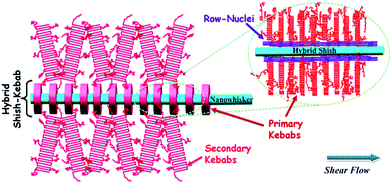 | ||
| Fig. 2 Schematic representation of the multiple kebab induced by the nanowhisker. The flow direction is horizontal. | ||
To complement the SEM observation, two-dimensional small-angle X-ray scattering (2D-SAXS) measurements were conducted to offer quantitative insights into the tenacious crystalline interphase between ZnO whiskers and PLA matrix for the structured PLA, as shown in Fig. 3. The scattering reflection of oriented crystals is observed exclusively in the structured PLA, displaying a pair of symmetrical triangular streaks in the equatorial direction and a pair of bulb-shape lobes in the meridional direction (Fig. 3A). This apparently reveals the presence of shear-aligned shish and lamellae decorated at the shish and whiskers, in accordance with the SEM observations. Fig. 3B illustrates the 1D-SAXS intensity profiles which produce the long period (L) regarding the lamellar structure. We note that the structured PLA presents an L of 21.5 nm, reflecting a statistical averaging outcome for the lamellar spacing in the transcrystallinity and classic shish–kebabs and hybrid shish–kebabs.48 Furthermore, based on the L and crystallinity (χc = 49.2%, Fig. S17†), the lamellar thickness (Lt) can be calculated to be 10.6 nm (Lt = L × χc). One may be amazed at the high coincidence between the thickness of oriented lamellae and that of the ultrathin organic layer existing in shell that encases the ceramic component (∼10 nm).22 It is obvious that the building units of the structured PLA and shell are of similar size, indicating the potential to offer multiple functions and achieve the shell-mimicking structure.
The above results permit the assumption that shell-mimicking structural configurations are established in the structured PLA: the oriented whiskers and classic shish–kebabs can be regarded as the rigid ceramic phase, while the interfacial crystalline entities can function as the tenacious linkages like the organic phase of shell. Reasonably, one may expect exceptional performances of the structured PLA. It is apparent that the unique shell-mimicking structure greatly benefits the mechanical properties of PLA, as demonstrated in Fig. 4A. We see from Fig. S18A† that the stress–strain curve of the structured PLA evidently towers over that of the normal PLA. Specifically, compared to the initial values of 64.9 and 1684 MPa of the normal PLA, the structured PLA obtains an unexpected promotion of yield strength and Young's modulus, achieving 119.4 and 2342 MPa, respectively (Fig. 4A). More importantly, the shell-mimicking structure permits the appreciable enhancement of ductility and toughness of the structured PLA, different from the usual sacrifice after incorporating stiff fillers. Particularly, Fig. 4A suggests the elongation at break and resistance to impact of the structured PLA achieve 8.7% and 11.5 KJ m−2, while the normal PLA shows values of only 7.3% and 4.5 KJ m−2, respectively. To clarify the superiority of the shell-mimicking approach over the traditional processing, we have compared the data regarding the increase ratio of tensile strength in this work and those reported in other PLA composite systems (Fig. 4B). It clearly suggests that the unprecedented optimization of tensile properties has been established under the common industrial processing conditions, while exceptional impact toughness has been simultaneously achieved for the structured PLA.
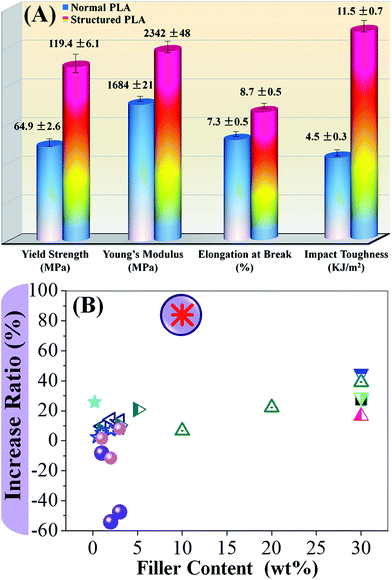 | ||
Fig. 4 Performance evaluation to demonstrate the exceptional mechanical properties of the structured PLA, as well as the excellent resistance to thermal deformation and specific anti-UV properties. (A) Detailed mechanical results regarding yield strength, Young's modulus, elongation at break and impact strength. (B) Comparison of increase ratio of tensile strength between ( ) this work and other PLA composite systems based on ( ) this work and other PLA composite systems based on ( ) glass fiber,57 ( ) glass fiber,57 ( ) man-made cellulose fiber,58 ( ) man-made cellulose fiber,58 ( ) abaca fiber,58 ( ) abaca fiber,58 ( ) jute fiber,58 ( ) jute fiber,58 ( ) ramie fiber,36 ( ) ramie fiber,36 ( ) cellulose nanowhisker,42 ( ) cellulose nanowhisker,42 ( ) cellulose nanofiber,59 ( ) cellulose nanofiber,59 ( ) multi-walled carbon nanotubes,60 ( ) multi-walled carbon nanotubes,60 ( ) graphene nanosheets,61 and ( ) graphene nanosheets,61 and ( ) untreated and ( ) untreated and ( ) silane treated ZnO,62 the increase ratio is defined as the increase in tensile strength to the initial value of pure PLA. ) silane treated ZnO,62 the increase ratio is defined as the increase in tensile strength to the initial value of pure PLA. | ||
The unusual combination of mechanical performances suggests interesting generalizations concerning the role of bioinspired structuring in creating evolutionary innovations and adaptive radiation for the manufacture of high-performance PLA. Practically, the traditional systems associated with the normal processing methods (e.g., compression, extrusion, injection molding, and spinning) have unfortunately resulted in fairly unimpressive performances or poor balance of properties. Limited promotion of strength and toughness was observed in the PLA composites and blends, even in newly developed systems.63–65 Here the unique shell-mimicking structure improves the strength, stiffness and toughness of PLA simultaneously, which is extremely attractive both academically and commercially.
Next, we characterize the large changes in anti-UV property (wavelength between 200 and 400 nm) and heat distortion resistance for the normal PLA and structured PLA, as shown in Fig. 5A and B. Presumably, a very weak UV absorption occurs in the normal PLA. After achieving the shell-mimicking structure, the structured PLA shows almost perfect UV light shielding efficiency. Fig. 5B confirms the strong modification of the heat distortion resistance for the structured PLA by conducting a simple hanging experiment in the oven. The structured PLA sample still preserves its original shape after hanging on the heated steel plate (160 °C) for up to 60 min, while the normal PLA experiences destructive heat distortion. These observations emphasize that the design of shell-mimicking structural configurations introduces the capacity to resist loading and deformation occurring under complex circumstances for PLA, especially under environments over 100 °C.66
Recent studies have demonstrated the promising application of PLA as an ideal green biopolymer to provide desired renewability, biocompatibility and biodegradability. The manufacture of PLA based structured materials with reasonable efficiency is an attractive goal, the present effort indicates a satisfactory attempt which will motivate further potential in expanding the applications of PLA. One may expect unusual fracture behavior of the structured PLA, judging from the unprecedented performance in terms of exceptional promotion in strength, stiffness, ductility and toughness. The fracture behaviors of the structured PLA and normal PLA are appraised from the fractured surfaces after tensile failure, as described in Fig. 6. Notably, one clearly observes that some significant changes differentiate the fractured surface of the structured PLA from that of the normal PLA. The fractured surface of the structured PLA is extremely coarse and bumpy with a scale-like appearance (Fig. 6b), which is indicative of extensive plastic deformation developed during fracture, in sharp contrast to the flat and smooth morphology of the normal PLA without any trace of plastic deformation (Fig. 6a). Such an observation of a brittle-to-ductile transition is indeed a remarkable phenomenon that is rarely reported in plasticizer-free PLA composite systems, in favor of dissipating a large amount of energy. It is also worth mentioning that the structured PLA presents substantially enhanced interfacial adhesion as evidenced by the close, tight bonding (Fig. 6b and S20†).
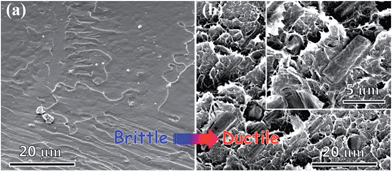 | ||
| Fig. 6 SEM micrographs of fractured surfaces after tensile failure showing the fundamental transition from the brittle fracture of (a) normal PLA to the ductile fracture of (b) structured PLA. | ||
We further attempt to explain the shell-mimicking features existing in the structured PLA that give rise to the unexpected brittle-to-ductile transition. Fig. 7 extracts the key architectural features shared by the structured PLA and shell, leading to the common definition of two function systems: the ordered high-strength phase and tenacious interphase. It is fairly convincing that such a structured composite system, showing the basic structuring of shell, is biomimetic in its origins, as shown in Fig. 7. The well aligned shish–kebabs, micro-sized whiskers and nanowhiskers render a multifunctional reinforcement of the PLA matrix. Specifically, the micro-sized whiskers provide excellent mechanical performance to the composite within the plane, while the shish–kebabs and nanowhiskers work at the nanoscale and enhance the through-thickness properties.67 As for the PLA lamellae arranged at the whiskers (i.e., hybrid shish–kebab and transcrystallinity), they are strong as well as resilient and can be regarded as the ligament or filament formation in the interfaces. When encountering the impact deformation, the tight shish–kebabs and whiskers show strong retardation of crack propagation, and cracks are prone to traverse across the thickness of them quite easily rather than the conventional linear development. This ultimately leads to the unusual observation of foliated surface from layer to layer (Fig. 6b). This mechanism can be substantially assisted by the interfacial superstructures, like a kind of sheath, that may create crack bridging with the dissipation and absorption of much energy.68 The combination of multiscale reinforcement and strong interfacial bonding desirably permits the effective transfer of applied stress and impact load from layer to layer in the structured PLA, resulting in the brittle-to-ductile transition.69 In this perspective, we provide the means for creating a structured composite system with shell-mimicking configurations that exhibits impressive combinations of mechanical response. Of paramount significance is the optimized biomimetic solution that will inspire and provide design principles for the rational design and reproducible construction of biobased structural composites with multiscale structures for multifunctional integration.
Conclusions
In the present work, an unprecedented shell-mimicking methodology has been developed for structuring PLA with the goal of doubling the strength and toughness. Particularly, customized multiscale ZnO whiskers were introduced to function at different length scales, while an intensive shear flow was employed during the injection molding to organize the whiskers and to build strong interfacial ligaments. The structured PLA was essentially a direct copy of shell. It was a surprise to find the high coincidence shown in the size of their building units (∼10 nm). Resulting from the shell-mimicking features, the structured PLA yielded high tensile strength and impact toughness (119.4 MPa and 11.5 KJ m−2), representing specific properties in great need for structural and medical applications. Of particular interest are the largely enhanced resistance to heat distortion and perfect UV light shielding efficiency.The proposed biomimetic methodology for materials design should be broadly applicable to the industrial manufacturing of various structural polymer composites, because uncontrollable organization of incorporated fillers and poor interfacial bonding are commonly encountered problems in high-performance composite preparation. The key elements in our methodology are the design of multiscale fillers and engineering control of shear flow, which have rarely been studied for structuring polymer composites despite their importance in practical processing. We anticipate that this effort will to help advance the structure-by-bionics approach in the fabrication of other composites toward low-cost, high-performance, large-scale commodities.
Acknowledgements
The authors gratefully thank the financial support from the National Natural Science Foundation of China (Grants 51120135002, 51203104 and 51121001), the Innovation Team Program of Science & Technology Department of Sichuan Province (Grant 2013TD0013), the Programme of Introducing Talents of Discipline to Universities (B13040) and the Doctoral Program of the Ministry of Education of China (Grant 20130181130012).Notes and references
- L. Borchardt, M. Oschatz and S. Kaskel, Mater. Horiz., 2014, 1, 157 RSC.
- A. B. Djurišić, Y. H. Leung and A. M. Ching Ng, Mater. Horiz., 2014, 1, 400 RSC.
- A. S. Aricò, P. Bruce, B. Scrosati, J.-M. Tarascon and W. Van Schalkwijk, Nat. Mater., 2005, 4, 366 CrossRef PubMed.
- B. Kolodziejczyk, O. Winther-Jensen, C. H. Ng, S. Lin, Q. Bao and B. Winther-Jensen, Mater. Horiz., 2014, 1, 452 RSC.
- K. Lee, M. D. Losego, D. H. Kim and G. N. Parsons, Mater. Horiz., 2014, 1, 419 RSC.
- W. Li, M. Liu, S. Feng, X. Li, J. Wang, D. Shen, Y. Li, Z. Sun, A. A. Elzatahry, H. Lu and D. Zhao, Mater. Horiz., 2014, 1, 439 RSC.
- Y. Liao, T. P. Farrell, G. R. Guillen, M. Li, J. A. T. Temple, X.-G. Li, E. M. V. Hoek and R. B. Kaner, Mater. Horiz., 2014, 1, 58 RSC.
- X. Zhang, L. Chen, T. Yuan, H. Huang, Z. Sui, R. Du, X. Li, Y. Lu and Q. Li, Mater. Horiz., 2014, 1, 232 RSC.
- J. Zhang, J. Wang and H. Tian, Mater. Horiz., 2014, 1, 169 RSC.
- F.-X. Xiao, J. Miao and B. Liu, Mater. Horiz., 2014, 1, 259 RSC.
- J. Raeburn, B. Alston, J. Kroeger, T. O. McDonald, J. R. Howse, P. J. Cameron and D. J. Adams, Mater. Horiz., 2014, 1, 241 RSC.
- R. J. Moerland, J. E. Koskela, A. Kravchenko, M. Simberg, S. van der Vegte, M. Kaivola, A. Priimagi and R. H. A. Ras, Mater. Horiz., 2014, 1, 74 RSC.
- M. Antonietti, Nat. Mater., 2003, 2, 9 CrossRef CAS.
- R. M. Erb, R. Libanori, N. Rothfuchs and A. R. Studart, Science, 2012, 335, 199 CrossRef CAS PubMed.
- C. Sanchez, H. Arribart and M. M. G. Guille, Nat. Mater., 2005, 4, 277 CrossRef CAS.
- T. Saito, Y. Oaki, T. Nishimura, A. Isogai and T. Kato, Mater. Horiz., 2014, 1, 321 RSC.
- K. Liu and L. Jiang, ACS Nano, 2011, 5, 6786 CrossRef CAS PubMed.
- J. Wang, Q. Cheng, L. Lin and L. Jiang, ACS Nano, 2014, 8, 2739 CrossRef CAS PubMed.
- Q. Cheng, M. Li, L. Jiang and Z. Tang, Adv. Mater., 2012, 24, 1838 CrossRef CAS PubMed.
- H. Yao, G. Zheng, W. Li, M. T. McDowell, Z. Seh, N. Liu, Z. Lu and Y. Cui, Nano Lett., 2013, 13, 3385 CrossRef CAS PubMed.
- X. Yao, Y. Song and L. Jiang, Adv. Mater., 2011, 23, 719 CrossRef CAS PubMed.
- G. Mayer, Science, 2005, 310, 1144 CrossRef CAS PubMed.
- Q. Cheng, M. Wu, M. Li, L. Jiang and Z. Tang, Angew. Chem., Int. Ed., 2013, 52, 3750 CrossRef CAS PubMed.
- Q. Cheng, L. Jiang and Z. Tang, Acc. Chem. Res., 2014, 47, 1256 CrossRef CAS PubMed.
- J. Wang, Q. Cheng, L. Lin, L. Chen and L. Jiang, Nanoscale, 2013, 5, 6356 RSC.
- L. Xie, H. Xu, Z.-P. Wang, X.-J. Li, J.-B. Chen, Z.-J. Zhang, H.-M. Yin, G.-J. Zhong, J. Lei and Z.-M. Li, J. Polym. Res., 2014, 21, 357 CrossRef.
- V. Arias, A. Höglund, K. Odelius and A.-C. Albertsson, Biomacromolecules, 2013, 15, 391 CrossRef PubMed.
- M. Persson, G. S. Lorite, S.-W. Cho, J. Tuukkanen and M. Skrifvars, ACS Appl. Mater. Interfaces, 2013, 5, 6864 CAS.
- S. Van Vlierberghe, P. Dubruel and E. Schacht, Biomacromolecules, 2011, 12, 1387 CrossRef CAS PubMed.
- P. Zhang, H. Wu, H. Wu, Z. Lù, C. Deng, Z. Hong, X. Jing and X. Chen, Biomacromolecules, 2011, 12, 2667 CrossRef CAS PubMed.
- N. Delpouve, G. Stoclet, A. Saiter, E. Dargent and S. Marais, J. Phys. Chem. B, 2012, 116, 4615 CrossRef CAS PubMed.
- J. Sun, H. Yu, X. Zhuang, X. Chen and X. Jing, J. Phys. Chem. B, 2011, 115, 2864 CrossRef CAS PubMed.
- A. J. Svagan, A. Åkesson, M. Cárdenas, S. Bulut, J. C. Knudsen, J. Risbo and D. Plackett, Biomacromolecules, 2012, 13, 397 CrossRef CAS PubMed.
- N. Vasanthan, H. Ly and S. Ghosh, J. Phys. Chem. B, 2011, 115, 9556 CrossRef CAS PubMed.
- F. D'Angelo, I. Armentano, I. Cacciotti, R. Tiribuzi, M. Quattrocelli, C. Del Gaudio, E. Fortunati, E. Saino, A. Caraffa, G. G. Cerulli, L. Visai, J. M. Kenny, M. Sampaolesi, A. Bianco, S. Martino and A. Orlacchio, Biomacromolecules, 2012, 13, 1350 CrossRef PubMed.
- H. Xu, C.-Y. Liu, C. Chen, B. S. Hsiao, G.-J. Zhong and Z.-M. Li, Biopolymers, 2012, 97, 825 CrossRef CAS PubMed.
- N. Lavielle, A. Hébraud, G. Schlatter, L. Thöny-Meyer, R. M. Rossi and A.-M. Popa, ACS Appl. Mater. Interfaces, 2013, 5, 10090 CAS.
- K. Zhang, A. K. Mohanty and M. Misra, ACS Appl. Mater. Interfaces, 2012, 4, 3091 CAS.
- V. Ojijo, S. Sinha Ray and R. Sadiku, ACS Appl. Mater. Interfaces, 2012, 4, 6690 CAS.
- Z. Kulinski, E. Piorkowska, K. Gadzinowska and M. Stasiak, Biomacromolecules, 2006, 7, 2128 CrossRef CAS PubMed.
- C. Zhou, Q. Shi, W. Guo, L. Terrell, A. T. Qureshi, D. J. Hayes and Q. Wu, ACS Appl. Mater. Interfaces, 2013, 5, 3847 CAS.
- M. Martínez-Sanz, A. Lopez-Rubio and J. M. Lagaron, Biomacromolecules, 2012, 13, 3887 CrossRef PubMed.
- F. Bouville, E. Maire, S. Meille, B. Van de Moortèle, A. J. Stevenson and S. Deville, Nat. Mater., 2014, 13, 508 CrossRef CAS PubMed.
- M. A. Meyers, J. McKittrick and P. Y. Chen, Science, 2013, 339, 773 CrossRef CAS PubMed.
- V. B. Schwartz, F. Thétiot, S. Ritz, S. Pütz, L. Choritz, A. Lappas, R. Förch, K. Landfester and U. Jonas, Adv. Funct. Mater., 2012, 22, 2376 CrossRef CAS.
- X. Zhou, T. Lin, Y. Liu, C. Wu, X. Zeng, D. Jiang, Y.-a. Zhang and T. Guo, ACS Appl. Mater. Interfaces, 2013, 5, 10067 CAS.
- H. Xu, G.-J. Zhong, Q. Fu, J. Lei, W. Jiang, B. S. Hsiao and Z.-M. Li, ACS Appl. Mater. Interfaces, 2012, 4, 6774 CAS.
- H. Xu, L. Xie, Y.-H. Chen, H.-D. Huang, J.-Z. Xu, G.-J. Zhong, B. S. Hsiao and Z.-M. Li, ACS Sustainable Chem. Eng., 2013, 1, 1619 CrossRef CAS.
- Y.-H. Chen, G.-J. Zhong, Y. Wang, Z.-M. Li and L. Li, Macromolecules, 2009, 42, 4343 CrossRef CAS.
- H. Xu, L. Xie, X. Jiang, X.-J. Li, Y. Li, Z.-J. Zhang, G.-J. Zhong and Z.-M. Li, J. Phys. Chem. B, 2014, 118, 812 CrossRef CAS PubMed.
- B. Larin, C. A. Avila-Orta, R. H. Somani, B. S. Hsiao and G. Marom, Polymer, 2008, 49, 295 CrossRef CAS PubMed.
- H. Xu, L. Xie, X. Jiang, M. Hakkarainen, J.-B. Chen, G.-J. Zhong and Z.-M. Li, Biomacromolecules, 2014, 15, 1676 CrossRef CAS PubMed.
- H. Fang, Y. Zhang, J. Bai and Z. Wang, Macromolecules, 2013, 46, 6555 CrossRef CAS.
- A. Jabbarzadeh and R. I. Tanner, Macromolecules, 2010, 43, 8136 CrossRef CAS.
- B. Shen, Y. Liang, C. Zhang and C. C. Han, Macromolecules, 2011, 44, 6919 CrossRef CAS.
- F. Zuo, J. K. Keum, L. Yang, R. H. Somani and B. S. Hsiao, Macromolecules, 2006, 39, 2209 CrossRef CAS.
- M. Huda, L. Drzal, A. Mohanty and M. Misra, Compos. Sci. Technol., 2006, 66, 1813 CrossRef CAS PubMed.
- A. K. Bledzki and A. Jaszkiewicz, Compos. Sci. Technol., 2010, 70, 1687 CrossRef CAS PubMed.
- M. Jonoobi, J. Harun, A. P. Mathew and K. Oksman, Compos. Sci. Technol., 2010, 70, 1742 CrossRef CAS PubMed.
- C.-S. Wu and H.-T. Liao, Polymer, 2007, 48, 4449 CrossRef CAS PubMed.
- Y. Cao, J. Feng and P. Wu, Carbon, 2010, 48, 3834 CrossRef CAS PubMed.
- M. Murariu, A. Doumbia, L. Bonnaud, A. L. Dechief, Y. Paint, M. Ferreira, C. Campagne, E. Devaux and P. Dubois, Biomacromolecules, 2011, 12, 1762 CrossRef CAS PubMed.
- R. N. Darie, E. Pâslaru, A. Sdrobis, G. M. Pricope, G. E. Hitruc, A. Poiată, A. Baklavaridis and C. Vasile, Ind. Eng. Chem. Res., 2014, 53, 7877 CrossRef CAS.
- K. M. Z. Hossain, M. S. Hasan, D. Boyd, C. D. Rudd, I. Ahmed and W. Thielemans, Biomacromolecules, 2014, 15, 1498 CrossRef CAS PubMed.
- H. Zhao, Z. Cui, X. Sun, L.-S. Turng and X. Peng, Ind. Eng. Chem. Res., 2013, 52, 2569 CrossRef CAS.
- X. Zhang, R. Nakagawa, K. H. K. Chan and M. Kotaki, Macromolecules, 2012, 45, 5494 CrossRef CAS.
- E. Bekyarova, E. T. Thostenson, A. Yu, M. E. Itkis, D. Fakhrutdinov, T.-W. Chou and R. C. Haddon, J. Phys. Chem. C, 2007, 111, 17865 CAS.
- S. Kamat, X. Su, R. Ballarini and A. Heuer, Nature, 2000, 405, 1036 CrossRef CAS PubMed.
- E. Bekyarova, E. Thostenson, A. Yu, H. Kim, J. Gao, J. Tang, H. Hahn, T.-W. Chou, M. Itkis and R. Haddon, Langmuir, 2007, 23, 3970 CrossRef CAS PubMed.
Footnotes |
| † Electronic supplementary information (ESI) available. See DOI: 10.1039/c4mh00085d |
| ‡ These authors contributed equally to this work. |
| This journal is © The Royal Society of Chemistry 2014 |

